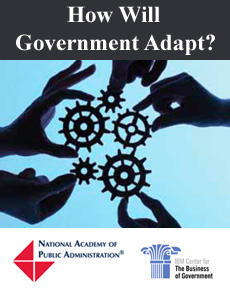
How Will Government Adapt?: Technology—Increasingly Everywhere

This is the second blog post in a series that sums up highlights of sessions held as part of the annual meeting in mid-November of the National Academy of Public Administration. This panel was moderated by Karen S. Evans, National Director, Partner, US Cyber Challenge and KE&T Partners LLC (and former head of e-government in the Office of Management and Budget). Panelists Mark A. Forman, Vice President, IT Services and Cloud Initiatives Dan Chenok, Executive Director, IBM Center for The Business of Government Highlights Background. The focus of this session was “the internet of things”— in the very near future, every device will be a “smart” device with the ability to collect and relay data. This data is being collected by both the private sector and the government, raising the issue of privacy—what is being done with this data? Who owns this data? An additional key issue is the role of the government in digital connectivity, particularly since the private sector often does this faster and better. What should be the role of government, if any, in collecting and utilizing this data, or should the government defer to the private sector for data management ? Some Key Insights Raised: Technology tends to becomes relevant to the political agenda only when there is afailure, (e.g., the 9/11 terrorist attacks were viewed as a failure in relaying information; the Affordability Care Act’s website did not work properly on launch). The government often continues to look at technology, staffing, and related issues in a silo for each agency rather than integrating the delivery channel of government services across agencies Even if state and local governments lead on applying technology to service delivery, there can still be a role for the national government in terms of the internet of all things, but what is this role? A “big” issue right now is that the government does not always tell citizens what it is doing with their data, and many citizens do not trust the government to be able to protect their personal data. Decisions in the government are often made on principles rather than evidence from data. How can the availability of data get people to make more informed decisions while still respecting their principles? How do you create a different privacy balance where people can take advantage of data, but also need to understand that if they opt-in that there might be greater access to personal information? There is interest in a more bottoms-up approach—data scientists taking data and analyzing it, and experimentation is occurring at a lower level and then moving up through the organization. For example, the evolution of IVDS—Interactive Visualized Data Systems – is occurring at the grassroots in some organizations, not as a top-down initiative. (summary by Allison Brigati, NAPA) Visit the landing page of this initiative where you can learn of future blog post topics and follow previous conversations.



